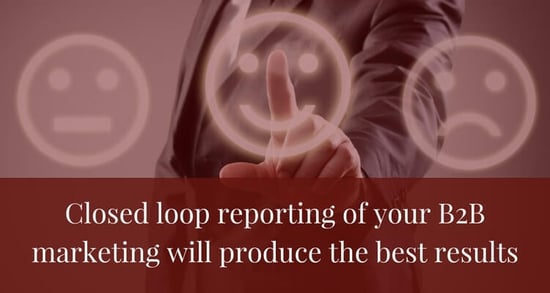B2B Email Marketing - How to Improve your Response Rate
Closed Loop Reporting of Your B2B Marketing Will Produce the Best Results
What is Closed Loop Reporting?
At the most basic level, closed loop reporting brings together marketing and sales data to complete the picture of what is working (or not).
CMO reported that “50% of B2B marketing executives find it difficult to attribute marketing activity directly to revenue results as a means to justify budgets.”

If we, as marketers, are unable to justify our actions from a commercial perspective, are we declaring our campaigns are based on guesswork? A scary thought.
Big Data is Headline News
The noise of big data is too loud to be ignored. Every director and decision maker around the world knows that data is out there, it just has to be taken, analyzed and used - which we know is the hard part.
We’re getting smarter too - when was the last time an advertising rep bamboozled you with big claims of ‘millions of hits’? Oh please! We want click through and conversion rates, not big numbers with small substance!
If you want to get up to speed on the basics of analysis, start here: Analyzing Results to Improve ROI.
Where to Start
Time to get comfortable with some terminology!
- Attribution Modeling - No Clay Required.
This simply shows us how the value of a sale is attributed to the marketing methods that instigated the sale. A quick example: Jane searches online for ‘wonder widget’, she clicks a PPC advert, arrives on your site and then leaves. She comes back later directly to your website and buys a widget.
In first point attribution modeling, the sale would be attributed to PPC. In last point attribution modeling, the sale would go to Direct website visitors.
These are the two most common attribution models, but there are many more where value can be spread amongst different touch points.
- Buyer Personas
These go by many names: avatars, buyer profiles and personas. Essentially it is a blueprint of your ideal customer. Learn more in our article Do you really know your target audience?
- Segmentation
This is all about slicing and dicing your data in different ways. It can include looking at a smaller set of data to see if the overall averages remain true. Basic filters in Excel are a great example of segmentation and invaluable when analyzing any data-set.
- Goals
Nothing to do with soccer (or football for our international readers). This is all about the specific marketing results we’re aiming for.
Success is Data
Data can be interpreted in many ways - and it’s often dependent upon how it’s presented. As a marketer, you want to focus on presenting data in a commercial way - i.e. marketing action. A resulted in sales delivery B ($$$).
To do this, you need to close the loop between sales and marketing.
If you’re operating an e-commerce site this is relatively easy to do. Simply set up conversion points on your website (the virtual kerching of the cash register) and monitor through analytics- which channels and campaigns are driving the highest sales?
For marketers operating offline, or through a combination of online/offline media and sales, this is more challenging.
Bringing Offline Data Into Your Analytics
Think about where your data is sitting and how you could bring it together.
- Call Data
Telephone calls can be tracked and sales can be recorded through automated systems - search for call tracking solutions online or call us for advice.
- CRM Data
Speak to your sales team about adjusting their sales script, a simple ‘where did you hear about us’ can yield big insights.
- Customer Surveys
Great if your customers neither buy online nor over the phone, make a point of calling your best customers and find out more about their sales journey.
Bringing the Data Together
This is where the power of closed loop reporting plays out. In an ideal world all your data would aggregate into a single system.
If you’re fortunate enough to have an in-house development team, or super stars in your IT department, it’s time to invest in some donuts and coffee - bribery can be highly effective in getting things done!
If that’s not an option, go for the big impact numbers - is marketing source most important or demographic data? Choose the data that will have the biggest impact on your marketing choices. Then work with Sales and IT to discuss the options available for recording the data in one place. It is essential that you can connect the marketing activity with the final sales outcome. It is even better if you can see other data (such as demographic information) alongside.
Closing the Loop
A large part of detailed reporting is drilling down to a granular level - how closely did the results match your intention? Once your data is connected you will be able to apply attribution models to see which marketing tactics are bringing you closer to your goals.
As you advance, choose segments of your data - perhaps refining your buyer personas to discover what works for one demographic vs. another.
How This Will Help You Perform Better
The biggest win is justifying your choices with tangible, commercial results. Think in terms of spend, revenue and margin and you’ll find some friends among the decision makers!
Next in line has to be the improvements to ROI that can be achieved. For instance, if you see that a specific demographic responds well to a campaign, but it fails to hit your target with another demographic, you can take steps to adjust your approach - nothing improves by being left alone! This is the point where we reject ‘adequate’ and aim higher!
Talk to an Expert
If you’re concerned that your external media isn’t reporting in ‘real value’ terms, Call Me. I help marketers, just like YOU, improve their reporting.
You can reach me, Donna Peterson at +1 860-210-8088 or email me directly dpeterson@worldinnovators.com.





